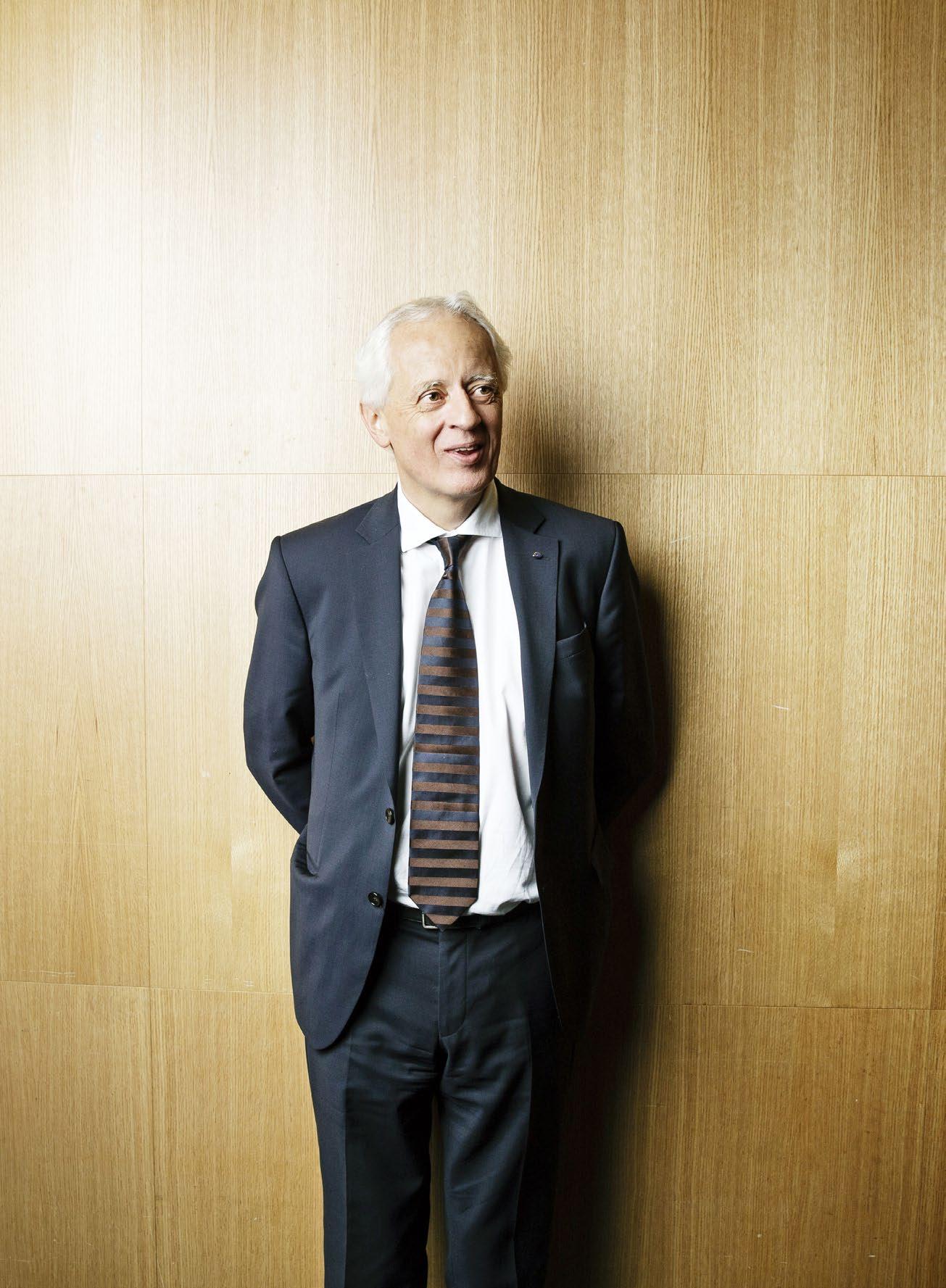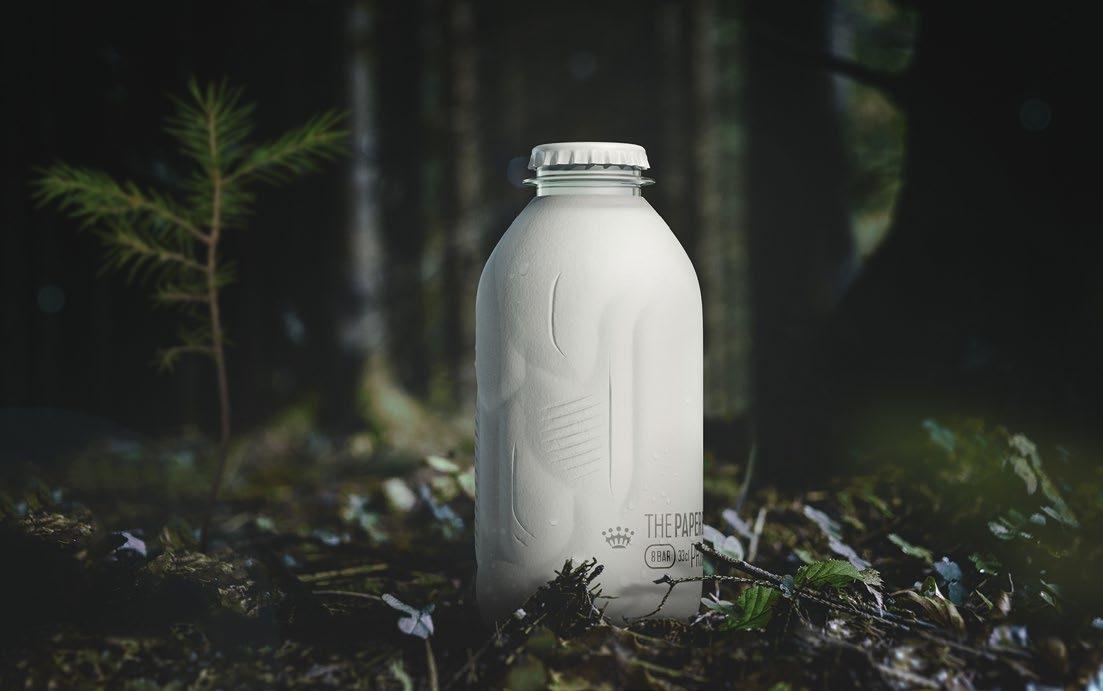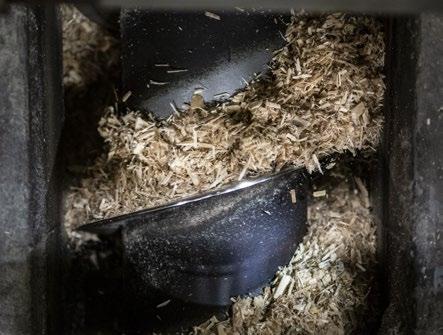
27 minute read
PAPER AND PAPERBOARD
Behind the building material cross-laminated timber lie decades of persistent research and an unwavering belief in wood.
But what do we really know about the properties of this material? What do we need to do more
research on, and what is needed for industrial wood construction to break through on a broad
front? We are looking for answers from Gerhard Schickhofer, the Austrian professor who has
spent 30 years of his life studying cross-laminated timber panels.
TEXT: LINN TREIJS PHOTO: MAGNUS LAUPA
IT ALL STARTED BY COMPLETE CHANCE. Gerhard Schickhofer received three offers for a doctoral programme. He chose the first – which happened to be wood.
“I’ve always been interested in spatial structure and panel structure, but because I had a background in steel engineering, my focus was more on steel and concrete. Combining panel structure with wood is perhaps the most important decision I’ve made,” he says.
He had no idea that the coming years’ research would lay the foundation for the development of a new construction material – cross-laminated timber – which makes it possible to build sustainable high-rise buildings and has the potential to change the entire construction industry. Today, 30 years later, there are 65 factories that manufacture cross-laminated timber, and another 15 are in progress.
“It’s an unbelievable development. When I started researching wood, there was no interest from industry – this topic only existed in the world of research,” he explains.
Developed with sawmills But Schickhofer saw that the material presented opportunities. After completing his PhD at Graz University of Technology, he began to collaborate with sawmills in the region, and a few years later one of them started the first commercial production of cross-laminated timber. “It’s a simple material that can be made from different fibres and species. That is why I think the concept is viable worldwide,” he says.
Over the years, Schickhofer has continued to study the material from all possible angles. His research team has tested how the panels are affected by changes in humidity, among other things. They discovered that the reaction of the wood is relatively minor, precisely because the different layers are glued together crosswise.
order to learn and borrow ideas from their standards and working methods.
“In the future, it will be important to replace concepts involving columns and floors in concrete, which have dominated our cities to date, with timber structures. It’s our job to show that it is actually possible, so that politicians and society can make the necessary decisions. A few years ago, wood was not an option – but it is today,” he says.
They have also studied load bearing, fixing methods, different ways of using the structural elements and how the technology can be applied to different types of wood, to name a few areas.
“Panel structures such as cross-laminated timber have always been the main focus of our research and still are today. The fact that we have not stopped focusing on this area is perhaps a reason why the material has become so successful,” he says.
New standard will be crucial Taking the results and knowledge out into the market has been a common thread throughout Schickhofer’s research. An important part of this work is his participation in the update of the European construction standard for Design of timber structures, Eurocode 5. The revised version is expected to be in place by 2023 and include instructions for cross-laminated timber, which he believes will be crucial for the future. “A well-written standard is required in order to reach the masses. It is a must if architects and structural engineers are to embrace a new material, as that is how they’re used to working. Without a perfect standard, they’ll go back to concrete,” he says.
This is why he also follows developments in the steel and concrete industry, in
Big changes for the construction industry Shifting the focus from concrete to wood means major changes for the construction industry – in both the planning and the construction phase, since much of the preparatory work is done in the factory.
“It was never our focus to change the construction industry, but now I think we will change it. We have the methods and tools required for wood to become the new basic material in multi-storey structures. It will change our way of thinking and our design philosophy, but naturally not overnight,” Schickhofer says.
So, what’s left to research? Schickhofer has a few ideas on the go. These include wanting to optimise the production chain relating to cross-laminated timber and glulam and developing multifunctional factories. Other areas are minimising the risk of moisture-induced damage and developing modular concepts with a high degree of prefabrication.
Curve pointing upwards In recent years, the market for cross-laminated timber has grown by 10–15 per cent per year, with production now standing at about two million cubic metres. Schickhofer would rather not try to predict the future, but when he looks ahead, he sees a steep curve that we are at the very beginning of. Within ten years, he estimates that the global production volume will be about
Professor Gerhard Schickhofer believes that crosslam has the potential to revolutionise the construction industry.
30 years with cross-laminated timber
1989–1994 Gerhard Schickhofer completes his PhD in cross-laminated timber at the Institute of Timber Engineering and Wood Technology at Graz University of Technology. 1998 KLH Massivholz is the first manufacturer in Austria to receive national technical approval for its cross-laminated timber. The product was developed and tested in collaboration with Schickhofer. Between 2005 and 2010, several large factories are built in Austria and Germany.
From 2010 to 2015, interest continues to grow globally, including in Japan, the United States, Canada and Australia. Crosslaminated timber also starts to be used in high-rise buildings, which helps to spread knowledge about the new possibilities of industrial wood construction. 2019 Gerhard Schickhofer is awarded the Marcus Wallenberg Prize for his research into and development of cross-laminated timber. Sweden has previously only had one manufacturer of cross-laminated timber, Martinsons, but in 2019 production multiplies when both Stora Enso and Södra set up new factories. Setra’s cross-laminated timber factory will start production in the first half of 2020.
three times higher than today, based on the presence of approximately 250 production lines.
“The big challenge en route to achieving this is not the raw material, because we have plenty of well-managed forests in Europe and use only a few percent. The bottleneck is the availability of knowledge and education,” he says.
In order to introduce a new material and concept to the market, people with in-depth knowledge are always required to drive its acceptance. He believes that this is especially important when it comes to cross-laminated timber, as the suppliers must understand and work closely with the customer.
“My experience is that the factories have to build networks with universities, architects and engineers. They also need to bring on board employees who are well trained in wood technology and can talk to customers in their own language. It’s a much closer relationship than when you sell sawn wood products,” he says.
Climate issue driving development When Schickhofer began his research, climate was a non-issue in the construction sector. Today, the situation is quite different. There is an expectation in society that the construction industry will reduce its carbon footprint, which is driving demand for renewable materials such as wood.
“It’s high time we did something about emissions. I hope cross-laminated timber can be a product that contributes to change and helps us move in the right direction,” says Gerhard Schickhofer. In the long run, he hopes that increased wood construction will not only contribute to a sustainable built environment but also boost rural communities. “I don’t like the focus on urbanisation. By developing more cross-laminated timber factories in rural areas, we’re building value chains that include the whole of society, not just the cities.”
Ready for action in Långshyttan

Setra is as clear as Gerhard Schickhofer about the potential for cross-laminated timber. After years of preparation, it is finally time to press the start button on the crosslam factory in Långshyttan. TEXT: KATARINA BRANDT PHOTO: OLA HÖGBERG
THE PEOPLE and the machines are all now in place, ready to get Setra’s production of crosslam elements in Långshyttan rolling on schedule. The new factory is an ultra-modern facility with machinery that is able to manufacture the largest crosslam elements in the market. The wood used in production largely comes from Setra’s own sawmill in Heby. The raw material originates from forests in central Sweden, making it about as locally grown as it can be.
“When it comes to detached houses, 90 per cent is already built in wood. Now we’re seeing wood construction also capture market share on larger projects. More and more builders have tried using crosslam and seen the benefits,” says Anna-Lena Gull, who is Vice President for Setra’s building solutions and responsible for getting the new factory established.
Efficient flow in the factory Over the past year, the plant has been fully prepared for crosslam production. Machines and equipment have been delivered in waves and assembled to create the efficient flow that characterises all of Setra’s other operations at Långshyttan.
Alongside the automated highbay warehouse stands the glue press, which plays a central role in the manufacture of cross-laminated timber. The largest in the world, it has a gigantic press table measuring an immense 6 x 20 metres, allowing two large crosslam sheets to be pressed side-by-side. The
Capacity to produce 100,000 m 3 • Setra’s crosslam factory in Långshyttan is able to produce 100,000 cubic metres per year. • The crosslam sheets can measure up to 3.6 m x 20 m, and be 60–300 mm thick. • The wood used in the crosslam sheets is FSC and PEFC certified.


At the heart of the factory is a Computer Numerical Controlled (CNC) machine that produces precision building elements cut out with millimetre accuracy.
beating heart of the operation is the computer-controlled CNC machine, which is fitted with a range of tools for everything from precision work to rougher cuts in the sheets. With two cutter heads, the task of machining the sheets is made significantly shorter.
Having a large-scale production facility provides considerable flexibility and the ability to offer the market’s broadest range of standard products, which also cuts down on waste.
“We are receiving enquiries all the time and there is great interest from construction companies large and small, but architects and structural engineers are also keeping an eye on developments. Cross-laminated timber is a new material in high demand that in many ways is changing the whole construction process,” says Cate Carlbom, a member of the crosslam sales team in the department for building solutions in Långshyttan. Under the operational model in the factory, each project is allocated a tailor-made team, with a variety of skills, which follows the project from start to finish.
“We believe in personal contact and want to provide support throughout the process. Industrial wood construction is still a new way of working for many people. It is therefore particularly important for them to have a supplier that can provide technical know-how and take
Cate Carlbom and Anna-Lena Gull expect Setra’s new crosslam factory in Långshyttan to get off to a flying start.

full responsibility for quality, reliable deliveries and sustainability,” says Anna-Lena Gull.
Crosslam and glulam in the same place Crosslam is also a form of glulam, although on a slightly larger scale, and the two products are almost always used together.
It is therefore beneficial to have the production and planning of crosslam and glulam based in the same location. This is appreciated not least by construction firm Byggpartner in Dalarna, which strives to build in wood wherever possible – often using products from Setra Långshyttan. “The material is in great demand and, of course, for us there is a huge benefit in having Setra’s crosslam factory close at hand. The fact that we can now buy both glulam and crosslam from Setra makes it even easier to choose wood for our projects,” says Johan Karlsson, who is a foreman for Byggpartner’s contracting business in Dalarna.
Setra’s investment in the new crosslam factory has got everyone in Långshyttan excited about the future. However, it is not just the local community, but the whole region that is seeing new opportunities emerge as the wood industry hub develops.
SETRA’S NEW CEO BELIEVES IN WOOD
Everyone should learn more about how wood benefits the climate and society. That’s the firm opinion of Katarina Levin, Setra’s new CEO. TEXT: LENA LIDBERG PHOTO: STEN JANSIN
KATARINA LEVIN HAS YEARS OF solid experience in the forest and wood industry. In January she took over the position as CEO at Setra and moved into the corner office at Setra’s Solna headquarters.
“Setra is in an exciting phase of development. It’s an honour to lead this modern wood industry company,” says Katarina Levin.
Setra’s new CEO has arranged her desk so that her back is to the window that opens onto the huge shopping mall. Instead she looks out onto a small park with some trees.
“I prefer this view,” she smiles. The previous day saw Katarina Levin set out on a tour of Setra’s units. Her first stop was Långshyttan where the new cross-laminated timber factory is being brought on stream. This new investment is right next door to Långsyttan’s glulam production and the plant’s manufacture of components for doors and windows.
“All in all, this is going to be a fantastic wood processing centre, unique in Sweden,” she says.
At the same time, Katarina Levin is eager to get to know the other Setra plants and sawmills, not least the new planing mill in Hasselfors and the progress of the pyrolysis business in Gävle. Her ambition is to get to know as many employees and customers as possible.
“Setra is to be a company with a flat hierarchy,” she says firmly.
ONE OF THE THINGS she wants to achieve as the company’s CEO is getting everyone actively involved. Her philosophy is that the foundation of good business is
an organisation that listens to customers’ needs and where all employees are seen and able to contribute their knowledge and engagement.
“A strong safety culture, good team spirit and efficient production – it all goes hand in hand. A safe plant with good timber flow is a productive plant,” she emphasises.
Katarina Levin is keen to build further on Setra’s vision and communication of the Grönsamhet (Green Profit) concept. She wants to emphasise the way Setra is involved in putting a value on the whole of Sweden’s forest-covered land. “Everyone should be educated on how wood benefits society and the climate. Wood is not only renewable and recyclable, it is a raw material that is climate positive in its own right. This is why it is so positive that we are seeing a longterm, global rise in consumption of wood products. It’s confirmation for us, our customers and society as a whole.”
Katarina Levin


AGE: 56. OCCUPATION: President and Group CEO of Setra since January 2020. BACKGROUND: MSc in Forestry Science. 28 years’ experience of forests and wood at SCA, including the post of Marketing Director at SCA Wood and Sawmill Manager at the Tunadal and Bollsta mills. LIVES: On a smallholding with forest on Sweden’s High Coast, in the village of Tjärned, Noraström. Commutes to the head office in Solna each week and rents a little wooden house in Sundbyberg. FAMILY: Married to Peter, Head of Technology for Kramfors municipality. Daughters Kristina, 24, and Ingrid, 22. LEISURE: “We spend our free time on the farm. There’s always something to do. We have about 20 beef cattle, two horses, a dog and two cats. I like doing physical work, everything from gardening and small construction projects using wood to being out in the forest with my chainsaw – wearing full protective gear of course! But I also enjoy relaxing on the sofa with a film or going cross-country skiing.”
Billerud Korsnäs is turning chips into smart packaging

Billerud Korsnäs is at the absolute forefront in developing and delivering the packaging of the future. The plant in Gävle manufactures material for more than 200 million drink cartons every day. Cellulose chips bought in from Setra’s sawmill in Kastet are an important raw material. TEXT: KAROLINA PIHLO PHOTO: OLA HÖGBERG

The 100% recyclable paper bottle from Billerud Korsnäs.
TO MAINTAIN ITS TRAILBLAZING POSITION, Billerud Korsnäs is wholeheartedly focused on innovation. Openness and curiosity about other people’s ideas is key.
Malin Ljung Eiborn, EVP Sustainability at Billerud Korsnäs, says that their mission is to challenge conventional packaging for a sustainable future. They are constantly asking the questions: What packaging has no-one ever made before? And how can the packaging that exists today be improved?
“We often drive innovation work in partnership with others, such as our customers. They rapidly sense the new needs that the market is looking to meet,” she explains.
“At the moment, the focus is on sustainability. Our customers want products that perform better on sustainability.”
Focus on solving challenges Historically, one of Billerud Korsnäs’ major innovations is formable and flexible paper. You’ll find it in the refrigerated produce section where it’s used for trays for sliced ham and cheese, for example. “Our FiberForm ® can even be used in our customers’ existing machinery, the same machines that used to be used for plastic, but with minor modifications. This makes the transition to the new paper-based material easier,” says Malin Ljung Eiborn.
The paper bottle is another more recent innovation that Billerud Korsnäs is proud of. It is 100 per cent recyclable and can be printed on. The innovation work was carried out jointly with several partners and major brands. At the moment

manufacturing is being scaled up and machines are being produced with the capacity to manufacture the paper bottle on a large scale.
“We are so proud to have cracked the code to create packaging made from paper that can be used for carbonated beverages,” says Malin Ljung Eiborn.
Malin elaborates on the fantastic potential now opening up for paper products. It is mainly driven by the huge interest in climate issues and in phasing out plastic. “And things are moving very quickly now. In just a few years, for example, we will have a new material for paper straws to replace plastic ones on the market,” she says.
World leader in liquid packaging board Billerud Korsnäs’ production unit in Gävle produces liquid packaging board, in other words, the material used to package milk, juice and chopped tomatoes, for example. The plant is a world leader in liquid packaging board. Every day it manufactures material for 200 million drink cartons. Cellulose chips bought in from Setra’s sawmill in Kastet, Gävle, are an important raw material.


Photo: Billerud Korsnäs


The quality of the chips is vitally important Per Utterström, manager of Billerud Korsnäs’ Gävle pulp mill, says that the chips need to be even in size and must under no circumstances be contaminated, for example with plastic.
“If a foreign substance comes in with the chips, it is likely that it will also enter the paperboard production line. That is not ok as we make products that are going to contain food,” Per explains.
“For liquid packaging board in particular, it’s also important that the material has the right strength and stability so that liquids can be poured into and out of the end product without it giving way.” Setra ran a project to improve the quality of its chips in 2019. Klas Flygare, Bioproducts & Raw Material Director at Setra, says that a special project group has been put together with input from all the sawmills in the Group to share experiences and review procedures. Among other things, this has led to greater knowledge and understanding of what the requirements are.
“The project is now complete and we are continuing to produce chips of the highest quality. We mustn’t drop the ball now. We need to work constantly to deliver what our customers want,” says Klas Flygare.
High demand for forest raw material Malin Ljung Eiborn at Billerud Korsnäs also points out that forest raw material is in high demand in many industries. Besides paper, forest raw material can be used for renewable fuel, textiles and to replace plastic.
“It has a lot to do with phasing out fossil raw material. Many industries are looking for alternatives and forest raw material is an attractive option,” she says.
Cellulose chips from Setra are an important raw material in manufacturing liquid packaging board in Gävle.
Photo: Billerud Korsnäs
“Now we have a new material for paper straws on the market instead of plastic ones,” says Malin Ljung Eiborn, EVP Sustainability at Billerud Korsnäs.
How chips are turned into packaging
1. FOREST Wood from wellmanaged forests is bought in. 2. DEBARKING The pulpwood is debarked. The bark is reused as fuel. 3. CHIPS Debarked wood is chopped into chips. 4. PULP PRODUCTION The chips are boiled with chemicals under pressure at a high temperature. Sulphate pulp is created. 5. REFINING The fibre pulp is cleaned and bleached where the product needs this. The pulp is washed and screened to make it as clean as possible. 6. PAPER AND PAPERBOARD PRODUCTION There are three steps to the manufacturing process: shaping, pressing and drying. The result is paper and paperboard, which the customer then turns into finished packaging.
WOOD SCHOOL
EPD – easier to compare and make green choices
How a construction product affects the environment during its life cycle is an increasingly important aspect to factor in when building from scratch. An environmental product declaration (EPD) shows the product’s footprint and makes it possible to compare materials and suppliers so that you can make a good environmental choice. TEXT: KATARINA BRANDT
DID YOU KNOW THAT a building’s climate impact during the construction process itself can be as big as or sometimes bigger than its impact over 50 years of use? This partly depends on the materials chosen to be used in construction and the type of heating energy used.
When a manufacturer is producing an EPD, and carries out a life cycle analysis of the product, this draws on a number of product-specific rules. The rules include detailed guidelines on definitions, choice of method and documentation for the product group concerned. The product-specific rules are usually termed “product category rules” (PCR) and are largely drawn up in consultation with the industry.
Provides an objective assessment An EPD is not a guarantee that the product is environmentally friendly but a tool to enable products and services to be compared. For example, it can serve as underlying documentation in procurement and purchasing or as a tool in environmental management work. The product category rules mean the EPD can form a basis for both objective assessments and fair comparisons of the environmental impact of goods and services in a life cycle perspective.
Because an EPD provides productspecific environmental information, it is an important source of data for a building’s life cycle analysis, LCA. Anyone conducting an LCA for a whole building or particular part of a building can use data from the EPD for the different construction products. It is important to remember that EPDs must be based on the same PCR in order to be comparable. It is also important to take the definitions in the respective EPD into account, e.g. regarding which phases are included in the calculations.
Greater focus on the climate impact of buildings Up until now it has been up to the client to demand and set requirements regarding EPDs in the construction industry but they are expected to become standard in Sweden in just a couple of years. The Swedish government is planning to introduce a requirement that buildings have climate
WHAT DO THE ABBREVIATIONS MEAN?
PCR
PRODUCT CATEGORY RULES To create an EPD, there must also be product-specific rules, PCR, that govern how data and other documentation is to be handled for the product in question.
EPD
ENVIRONMENTAL PRODUCT DECLARATION An environmental product declaration for a construction product that describes the product’s environmental impact throughout its entire life cycle. The input data generated by an EPD can be used when conducting a life cycle analysis of buildings.
LCA
LIFE CYCLE ANALYSIS A method for calculating environmental impact throughout a product’s entire life cycle from extraction of natural resources until the product is no longer used and has to be disposed of. An LCA lets you find out at which stage of a building’s life cycle a particular environmental impact is greatest.
declarations and has commissioned the National Board of Housing, Building and Planning to prepare the industry for this. The Board proposes that the parts of a building’s life cycle that generate the greatest greenhouse gas emissions must have declarations. Initially this will cover the first three steps of the life cycle, in other words raw material supply, transport and product manufacture. In the first instance, the purpose of the climate declaration is to increase awareness and knowledge of the climate impact of buildings. In the next step, the aim is to steer efforts to reduce climate impact and help to attain the national objective of a climate neutral Sweden by 2045.
Examined by an independent third party There are many different EPD programmes. One of them, EPD International, was launched in Sweden in 1998 but has gradually been reshaped into an international system. Today there are EPDs registered from 45 countries on four continents. All EPDs produced must be examined and verified by an independent third party. In Sweden, Swedac is the accreditation body for the certification bodies that carry out the examinations. EPD International is a subsidiary of IVL Swedish Environmental Research Institute. IVL also helps companies and organisations to produce EPDs in line with the international EPD system and develop associated product category rules (PCR).
You’ll find Setra’s environmental product declarations for cross-laminated timber and glulam at setragroup.com.
BIM
BUILDING INFORMATION MODELLING Building information modelling constructs a virtual model of the building in digital form. The model contains all available data on the material in the construction, including EPDs. This makes it possible to compare how big a building’s environmental impact would be using different construction materials.
KARIN SANNE is head of IVL Swedish Environmental Research Institute’s Life Cycle Management group. She coordinates and develops the institute’s LCA operations regarding commissioned projects and research. She also helps companies and organisations to understand the environmental impact of products from a life cycle perspective, produce EPDs and implement a life cycle approach.
What role do EPDs play in the sustainable value chain? They are important to the ability to communicate trustworthy information about a product from a value chain perspective. The product-specific rules for each product group provide comparability, which along with trustworthiness, is one of the cornerstones of EPDs. Without the information contained in an EPD, it is impossible to make choices based on the size of the product’s environmental impact.
As a builder, how are EPDs useful when choosing materials and suppliers? Sustainable procurement is an important area of use for EPDs as they enable comparisons to be made using the same basis for calculation. Because EPDs are always examined by an independent third party, they are also seen as highly trustworthy compared with other types of declaration.

What does the future look like for EPDs? Looking ahead, I think that many suppliers of construction materials will need to create EPDs for their products. We are already seeing interest increasing. There is a lot of talk about the climate impact of products and by 2022 the Swedish government intends to make climate declarations compulsory when new buildings are constructed. The climate is important but we need to expand the perspective by factoring in other environmental aspects such as pollution, eutrophication and exhausting resources. An EPD is designed to include many different environmental aspects, where climate impact is one parameter.
TALKING ABOUT TIMBER
New, efficient construction systems and greater climate awareness mean that building in wood is on the up in Sweden and around the world. Here three students share their views on wood and the role they think the material will play in the future.
TEXT: KATARINA BRANDT
What role will wood play in the sustainable urban planning of the future?

YI XIONG STUDYING CIVIL ENGINEERING AT DALIAN UNIVERSITY OF TECHNOLOGY IN DALIAN, CHINA.
Compared with concrete, wood is a more environmentally friendly material. Manufacturing construction materials made from wood releases less carbon dioxide than manufacturing other construction materials. Wood has many advantages and can be used for many purposes, including buildings and furniture. I think wood will play a major role in the transition to a sustainable society, although as a material it does have disadvantages we need to solve. The production of wood affects the forests and this is why it is important to work for sustainable forestry across the world in the future. This would enable us to build in wood while also supporting forest ecosystems, so strengthening the relationship between people and the environment, which sees us make eco-conscious choices. I think a difference between concrete and wood is that the indoor air is healthier in a wooden building. This is one of the reasons why I would like to live in a wooden building.

JULIA WALDHAGEN STUDYING FOR AN MSC IN ENGINEERING AT KTH ROYAL INSTITUTE OF TECHNOLOGY IN STOCKHOLM, SWEDEN.
I see wood as part of the solution in the transition to a sustainable society. If we are to combat the greenhouse effect, we need to minimise emissions at all phases of the construction process, not just in the operational phase of the building. Improving energy efficiency obviously works up to a certain point, but in the end you have to look at the major role played by the construction material at the production stage and in the long term. This is where I think wood offers great potential. It’s a renewable and reliable material that reduces construction time and climate footprint. Of course there are problems that need to be addressed, such as technical issues to do with acoustics and the stability of taller buildings. But this ought to lead to greater interest and encourage more research into wood as a material. I can definitely see myself living in a building made of wood, and for much of my life I have done so. Besides all the environmental benefits, wooden buildings are often incredibly beautiful.

STEPHAN HUBER STUDYING GEOGRAPHY AT LUDWIG-MAXIMILIANSUNIVERSITÄT IN MUNICH, GERMANY.
The warm look and feel that reminds me of being in the forest makes me want to live in a wooden building in the future. I find it hard to determine the potential of wood as a sustainable material. You have to factor in the health of the ecosystem in which we are planting the trees. This needs to be set in relation to the opportunities for biodiversity and carbon sinks, and how much energy is used by transport, manufacture and the construction process. Finally, it is also important to take into account lifetime and whether the material can be recycled. If the result is that wood has a lower environmental impact than other construction materials, I see clear potential for a shift. I think that for sustainable urban development we need to focus on less new building and instead invest in buildings with a long lifetime.




